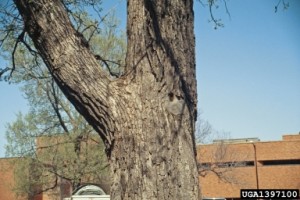Hurricane season is officially upon us! Although only 18 hurricanes have hit the DC metro area in the last 178 years, it’s common for us to experience residual rains and winds from hurricanes and tropical storms that make landfall further down the coast. Although not hurricanes, these storms still cause damage to healthy and unhealthy trees.
Some trees fare better in storms like white oak, sweetgum, black gum, and bald cypress. While others like silver maple, willow, and cherry, often experience broken limbs and uprooting. Whatever species tree you have, it’s best to make sure they are ready for summer storms by following the tips below.
1. Preventative Pruning

Regular tree maintenance can mean a world of difference when it comes to a tree’s strength during a storm. Preventative pruning reduces wind resistance and removes dead branches. This reduces the risk of the tree or the tree’s limbs snapping under the force of wind gusts.
2. Tree Inspection
The next time you’re out in your yard, take a minute and look at your tree. By inspecting your tree, you can spot structural issues that could increase the risk of your tree falling or limbs breaking during storms.
- Look for large branches attached with tight, v-shaped forks. These branches are prone to failure and may need to be lightened or removed.
- Look for cracks in the trunk of the tree or in major limbs and the presence of extensive deadwood.
- Look for cavities and hollow areas in your tree’s trunk.
- Look for fungi growing from the base of your tree or under its canopy. This could be a sign of root decay.
If you see any of these signs of structural issues we suggest you contact a Certified Arborist.
3. Mulching

This tip is surprising to most homeowners but proper mulching can help your tree weather storms. Proper mulching protects the root system of the tree and allows water and nutrients to drain down through the soil to the roots instead of flooding. Keeping the root system healthy through proper mulching can increase the tree’s strength year-round but especially during storms.
4. Move Items From Under Trees
In case your tree or its limbs do fail during a storm, make sure to remove items from under the tree’s canopy. For example, do not park your vehicle under a tree if you know a storm is approaching, better to be safe than sorry.
5. Take A Look At Your Neighbors’ Trees
Your neighbors’ trees aren’t on your property but that doesn’t mean they can’t come crashing down on your house, shed, or car. Do a visual examination of your neighbors’ trees to see if there are any tell-tale danger signs. Or better yet, talk to your neighbors about having an Arborist inspect their tree.

6. Bio-Stimulants & Root Health
Creating and maintaining a strong root system is incredibly important when it comes to withstanding storms. Unhealthy root systems are often the cause of a tree uprooting in a storm. Keep your tree’s root system healthy by giving it bio-stimulant treatments twice a year, a root collar excavation/root pruning when needed, and watering it properly.
Remember, trees are living organisms and there are a lot of factors that lead to a tree failing. Even properly maintained trees can fall in the correct conditions. However, preventative maintenance can decrease the risk of serious damage to your property from falling trees and limbs. Check out our article on why trees fall to learn more about the factors that contribute to the failure of a tree.
Need help with any of the tips above? Give us a call at 703-573-3029 or book an appointment online to meet with a Certified Arborist that can help your trees withstand summer storms.
We also provide emergency response if you do have a tree or limb that has fallen. Please call 703-573-3029 for assistance.



